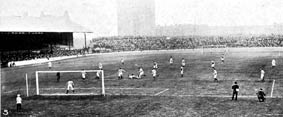
Chelsea vs. West Bromwich Albion at Stamford Bridge on 23 September 1905; Chelsea won 1–0.
Stamford Bridge was designed for the Mears family by the noted football architect Archibald Leitch. They offered to lease the stadium to Fulham, but were turned down. As a consequence, the owners decided to form their own football club to occupy their new ground. Most football clubs were founded first, and then sought grounds in which to play, but Chelsea were founded for Stamford Bridge. Since there was already a football club named Fulham in the borough, the founders decided to adopt the name of the adjacent borough of Chelsea for the new club, having rejected names such as Kensington FC, Stamford Bridge FC and London FC.
Starting with an open bowl-like design and one covered terrace, Stamford Bridge had an original capacity of around 100,000. The early 1930s saw the construction of a terrace on the southern part of the ground with a roof that covered around one fifth of the stand. It eventually became known as the "Shed End", the home of Chelsea's most loyal and vocal supporters, particularly during the 1960s, 70s and 80s. The exact origins of the name are unclear, but the fact that the roof looked like a corrugated iron shed roof played a part.
During the late 1960s and early 70s, the club's owners embarked on a modernisation of Stamford Bridge with plans for a 50,000 all-seater stadium. Work began on the East Stand in the early 1970s but the project was beset with problems and the cost almost brought the club to its knees, culminating in the freehold being sold to property developers. Following a long legal battle, it was not until the mid-1990s that Chelsea's future at the stadium was secured and renovation work resumed. The north, west and southern parts of the ground were converted into all-seater stands and moved closer to the pitch, a process completed by 2001.
When Stamford Bridge was redeveloped in the Ken Bates era many additional features were added to the complex including two hotels, apartments, bars, restaurants, the Chelsea Megastore, and an interactive visitor attraction called Chelsea World of Sport. The intention was that these facilities would provide extra revenue to support the football side of the business, but they were less successful than hoped and before the Abramovich takeover in 2003 the debt taken on to finance them was a major burden on the club. Soon after the takeover a decision was taken to drop the "Chelsea Village" brand and refocus on Chelsea as a football club. However, the stadium is sometimes still referred to as part of "Chelsea Village" or "The Village".
The Stamford Bridge pitch, the freehold, the turnstiles and Chelsea's naming rights are now owned by Chelsea Pitch Owners, a non-profit organisation in which fans are the shareholders. The CPO was created to ensure the stadium could never again be sold to developers. It also means that if the club moves to a new location, they could not use the Chelsea FC name.
The club plans to increase its capacity to over 50,000. Owing to its location in a built-up part of London on a main road and next to two railway lines, fans can only enter the stadium through the Fulham Road entrances, which places severe constraints on expansion due to health and safety regulations. As a result, Chelsea have been linked with a move away from Stamford Bridge to sites including the Earls Court Exhibition Centre, Battersea Power Station and the Chelsea Barracks. However, the club have reiterated their desire to keep Chelsea at their current home.
Chelsea's training ground is located in Cobham, Surrey. Chelsea moved to Cobham in 2004. Their previous training ground in Harlington was taken over by QPR in 2005.The new training facilities in Cobham were completed in 2007.


0 comments:
Post a Comment